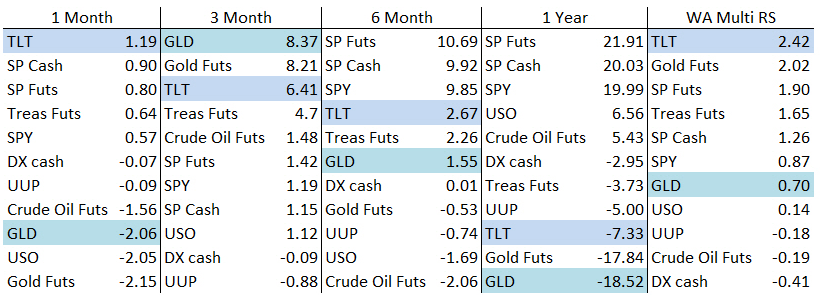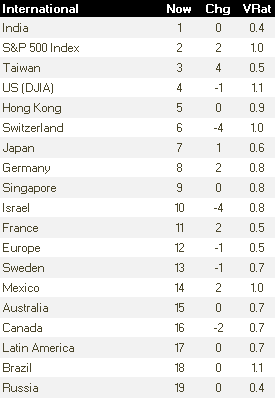Multi-asset relative strength comparisons
My previous post looked at the concept of comparing relative strength of two assets by comparing returns from a specific point in time. In that post, I suggested using a previous, structurally important, pivot as the comparison point, but there are some potential issues with that idea. Today, I will look a bit more at some of those issues, and suggest a possible solution.
One of the biggest issues with this way of tracking relative performance is that the starting point matters as much as the ending point. If has to be logically consistent--referring to a previous structurally important pivot makes sense if we are, for instance, comparing multiple stocks, but it may make much less sense if we are comparing disparate assets that have no structural connection. One of the most common solutions is simply to compare relative performance over an arbitrary lookback window (e.g., 1 month, 6 months), but now the choice of starting point becomes even more important.

Take a look at the table above which shows relative performance comparisons for a number of assets using different lookback periods. (This data is not current.) I highlighted TLT and GLD, just so you can see how they can slide from the top to the bottom of the ranking, simply based on the length of the lookback used. (There is considerably more discussion of this issue in my book

.) Usually, when we rank and compare performance figures like this, we call the tool "relative strength", and this is a key component in many trading systems. However, any time we introduce an arbitrary variable into a trading tool (as we have with lookback period, in this case), it demands some careful thought and attention.
One solution is to use an average of multiple lookback periods, as Bill O'Neil

suggests in his excellent book. Though this is not a perfect solution, as there can still be distortions based on large moves at one of the lookback endpoints, an average will solve many of the potential problems with using a single lookback period.

The table above is one that I publish weekly in my research reports, and has been a starting point for my weekly homework for more than a decade. I'm not so interested in the actual relative strength number--in fact, you can see that this table does not even publish the actual number, but only shows the rankings across global markets. (Shameless plug: this is only a very small part of what I publish each week, and only one piece of our trading methodology. We'd love to have you check out our work with a free trial.) Perhaps even more important is the next column, that shows the change in the rankings. I want to make sure I know what countries have made large moves, up or down. Maybe that is actionable information, but, at the very least, it's context and background that I must consider. This becomes even more important when looking at sectors and industries within one country.
I think that's the best way to consider this type of relative analysis: it is background and context. Perhaps vital background and context, but it's difficult to trade based on this information, and, because the entire relationship between a set of markets is collapsed to one number, we also lose a lot of detail. It's not possible to really understand the nature of that relationship. Tomorrow, we'll look at some tools that can help us actually set up and structure trades based on relative performance and relationships between multiple markets.



